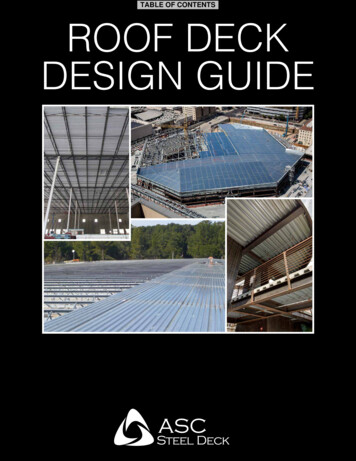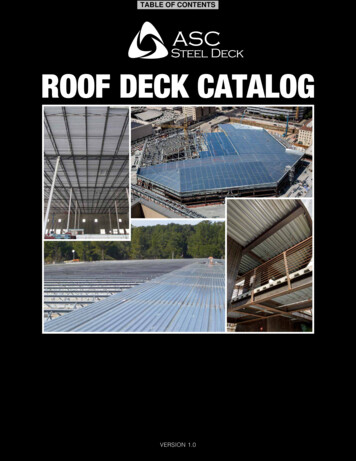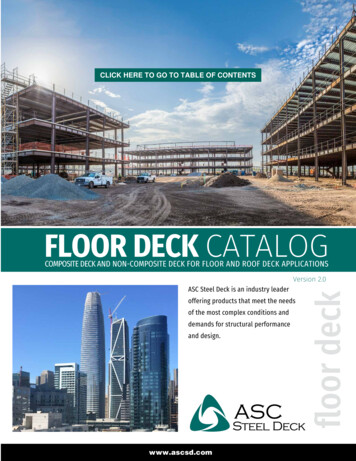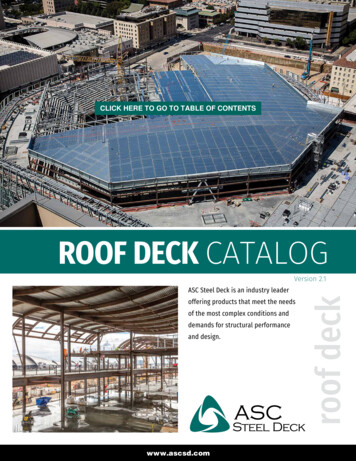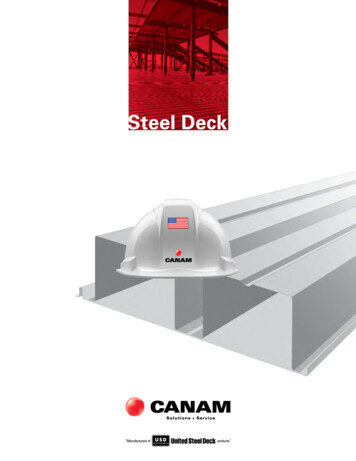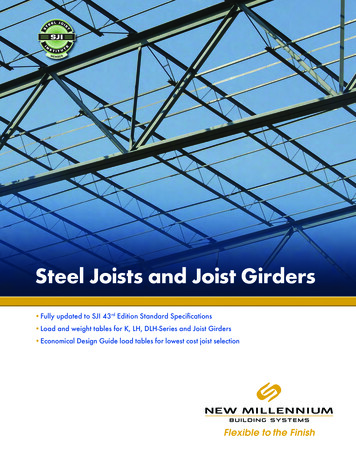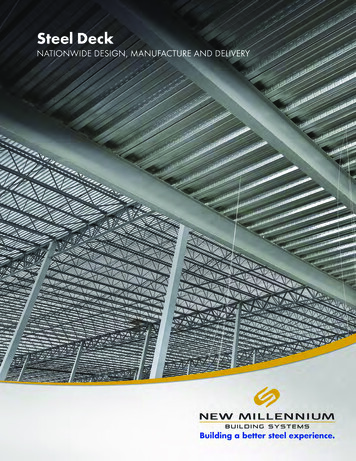
Transcription
Late Life Low Cost Deck OverlaysLate Life Low Cost Deck OverlaysFINAL REPORTMarch 10, 2020WJE No. 2018.8347PREPARED FOR:The Iowa Highway Research BoardTR-775PREPARED BY:Mohamed K. ElBatanouny, Ph.D., S.E., P.E.Le T. Pham, Ph.D.Kathleen A. HawkinsPaul D. Krauss, P.E.Wiss, Janney, Elstner Associates, Inc.
DISCLAIMERThe contents of this report reflect the views of the authors, who are responsible for the facts and theaccuracy of the information presented herein. The opinions, findings, and conclusions expressed in thispublication are those of the authors and not necessarily those of the sponsors.The sponsors assume no liability for the contents or use of the information contained in this document. Thisreport does not constitute a standard, specification, or regulation. The sponsors do not endorse productsor manufacturers. Trademarks or manufacturers' names appear in this report only because they areconsidered essential to the objectives of the document.STATEMENT OF NON-DISCRIMINATIONFederal and state laws prohibit employment and/or public accommodation discrimination on the basis ofage, color, creed, disability, gender identity, national origin, pregnancy, race, religion, sex, sexual orientationor veteran’s status. If you believe you have been discriminated against, please contact the Iowa Civil RightsCommission at 800-457-4416 or Iowa Department of Transportation's affirmative action officer. If you needaccommodations because of a disability to access the Iowa Department of Transportation’s services, contactthe agency's affirmative action officer at 800-262-0003.
Late Life Low Cost Deck OverlaysFinal ReportSponsored by:The Iowa Highway Research BoardTR-775Prepared by:Mohamed K. ElBatanouny, Le T. Pham, Kathleen A. Hawkins, andPaul D. KraussWiss, Janney, Elstner Associates, Inc.Northbrook, IllinoisMarch 10, 2020
TECHNICAL REPORT DOCUMENTATION PAGE1. Report No.TR-7754. Title and SubtitleLate Life Low Cost Deck Overlays2. Government Accession No.3. Recipient’s Catalog No.5. Report DateMarch 10, 20206. Performing Organization CodeWJE No. 2018.83477. Author(s)Mohamed K. ElBatanouny, Ph.D., S.E. http://orcid.org/0000-0001-9029-2104Le T. Pham, Ph.D. http://orcid.org/0000-0002-6348-4204Kathleen A. Hawkins, http://orcid.org/ 0000-0001-8447-987XPaul D. Krauss, P.E. http://orcid.org/0000-0002-0107-62568. Performing Organization ReportNo.9. Performing Organization Name and AddressWiss, Janney, Elstner Associates, Inc.330 Pfingsten RdNorthbrook, Illinois 6006210. Work Unit No.12. Sponsoring Agency Name and AddressIowa Department of TransportationIowa Highway Research Board (IHRB)800 Lincoln WayAmes, IA 5001013. Type of Report and PeriodCoveredFinal Report (May 2019- March 2020)WJE No. 2018.834711. Contract or Grant No.TR-77514. Sponsoring Agency CodeTR-77515. Supplementary Notes16. AbstractLow-slump dense concrete overlays (LSDC) are typically used by the Iowa DOT to provide long-term performance. However,due to their relatively high costs and long curing, LSDC overlays may not be the optimal solution for late-life bridge decks thatrequire a short service life extension prior to replacement. A literature review and cost-benefit analysis were conducted toidentify potential late-life overlays that are less expensive and have a smaller traffic impact than the LSDC overlay. Federal andstate research on overlays and the standards of eleven states in the Midwest and three additional states (California, New York,and Virginia) were reviewed. Seven types of overlays were selected for comparison to the LSDC overlay as follows: LMCVE,PPCO, thin polymer, HMA overlays, PMA overlays, and HMA overlays with waterproofing membranes (WPM). Reinforcedasphalt overlays were also identified as potential late-life overlays, but due to lack of data and literature, could not be includedin the analysis. A reduced construction procedure that does not require partial-depth repairs was also considered in additionto the standard procedure used by the Iowa DOT. Results of the analysis show that all of the overlays investigated can reducethe traffic closures by half the time and several overlay-construction procedure combinations can significantly reduce the costcompared with the LSDC overlay. Recommendations for selecting the optimal late life overlays based on the targeted remainingservice life were presented in terms of a decision making table that classifies the different options based on cost, traffic closuretimes, and expected service life. Field studies are recommended to verify the benefits of and service life associated with thereduced construction procedure discussed in this study. Additionally, it is recommended that a more refined cost-benefitanalysis be conducted for bridges with varying deck conditions and service life requirements to confirm the general applicabilityof the results of this study.17. Key WordsBridge, deck, late life overlays, low cost19. Security Classif. (of this report)18. Distribution StatementNo restrictions. This document is available to the publicfrom the sponsoring agency.20. Security Classif. (of thispage)21. No. ofPages12022. Price
Late Life Low Cost Deck OverlaysTR-775EXECUTIVE SUMMARYWhen a bridge deck is considered for replacement, it is not uncommon that the deck needs significantrepairs to maintain the riding surface until funding is available for the replacement and a constructioncontract can be executed. Traditionally, Iowa DOT has used low slump portland cement concrete overlayson bridge decks, which can provide a significant service life extension. Low-slump overlays, however, havesignificant costs and traffic impacts during construction. For bridges with a limited remaining service life,other deck overlay options that have lower costs and traffic impacts while maintaining the riding surfacemay be desirable. The goal of this study is to identify overlay options that have lower costs and trafficimpacts than the standard overlays currently used by the Iowa DOT, which are more desirable for a bridgedeck with a limited remaining service life.In this study, different overlay materials and reduced construction procedures were evaluated for shortextensions of late-life decks. Cost and traffic impact reductions can be obtained by changing twocomponents of an overlay system: materials and construction. Apart from low slump concrete used by IowaDOT (Class O), other hydraulic cement concrete overlays have been used including silica fume concrete,latex-modified concrete, high performance concrete, and ultra-high performance concrete. These concreteoverlays typically require at least three days of curing, substantially disrupting traffic. Materials that requireshorter curing times than conventional portland cement concrete such as polymer concrete, rapid setconcrete, or asphalt can reduce traffic impacts. Mixer-blended polyester polymer concrete overlays (PPCO),typically 3/4 inch or thicker, can be installed quickly and provide significant service life extensions. Thinpolymer overlays, typically applied in multiple (broom and seed) layers to achieve a thickness of 1/4 to 1/2inch, can be installed quickly and have reduced cost. Hot mix asphalt concrete (HMA) overlays can be lowcost and installed quickly. While HMA overlays with a water proofing membrane can provide significantservice life extensions, HMA overlays without a membrane may be acceptable as a very short-term solution.A reduced construction procedure that lowers or removes certain construction requirements can reduceboth costs and traffic impacts. The standard overlay procedure by Iowa DOT involves surveying for andremoving delaminated concrete to maximize service life of the overlay. While important for long-termdurability, these processes are labor- and time-consuming and can add a significant cost to the overlayproject. For decks that have a short remaining service life, removal of deteriorated concrete beforeplacement of the overlay may be omitted or lessened to decrease cost and construction time, which is anapproach followed by some DOTs as identified in the study.Before selecting an overlay system and construction process, decks must be evaluated, and the required lifeextension determined. Factors in the selection process include: condition of the deck, minimum service lifeextension desired, traffic impacts during construction, traffic loading such as ADTT, costs, availability ofmaterials and contractors, and time of year. Through a literature review and cost-benefit analysis for a typicallate-life deck condition, this study provides a discussion of the advantages and disadvantages of differentoverlay materials and construction procedures that have been used by other states compared with standardIowa practice. The different combinations of overlay materials and construction procedures have beensorted by service life extension and ranked in terms of cost and traffic impact. Finally, standard details andspecifications of promising late-life overlays have been drafted and can be incorporated into Iowa standardspecifications or used to develop special provisions for late life overlay projects in Iowa.FINAL REPORT March 10, 2020Page v
Late Life Low Cost Deck OverlaysTR-775ACKNOWLEDGEMENTSThe financial support provided by the Iowa Highway Research Board (IHRB) is gratefully acknowledged. Theauthors would like to thank Mr. Michael Todsen - Iowa DOT Office of Bridges and Structures and other TACmembers including Ms. Vanessa Goetz - Iowa DOT Office of Research & Analytics, Mr. David Evans - IowaDOT Office of Bridges and Structures, and Mr. Gregg Durbin - Iowa DOT District 1 Materials Engineer, fortheir input throughout the project.FINAL REPORT March 10, 2020Page vi
Late Life Low Cost Deck OverlaysTR-775CONTENTSChapter 1. Introduction . 11.1. Background . 11.2. Objectives . 21.3. Layout of Report . 2Chapter 2. Literature Review . 32.1. Overlay Types . 32.2. Standard Bridge Deck Overlay Practice in Iowa . 42.3. Bridge Deck Overlay Practices by Other State DOTs . 52.3.1. Hydraulic Cement Concrete Overlays . 52.3.2. Polymer Concrete Overlays . 62.3.3. Asphalt Overlays . 72.4. Reinforced Overlays .10Chapter 3. Analysis of Candidates for Late Life Low Cost Overlays .123.1. Cost-Benefit Analysis.123.1.1. Overlay Types for Cost-Benefit Analysis .123.1.2. Construction Procedures .123.1.3. Deck Condition .163.1.4. Construction duration .163.1.5. Cost Estimate .173.1.6. Cost-Benefit Comparison and Discussion .193.2. Selection of overlay solutions for late-life deck .193.3. Sensitivity of Cost to Repair Area .233.4. Standard Details and Specifications for Overlay Candidates .26Chapter 4. Conclusions and Recommendations .304.1. Summary and Conclusions .304.2. Recommendations .314.3. Implementation .32Bibliography .33APPENDIX A. Expanded literature reviewA.1 Comparison between Overlay Types .37A.1.1 Performance/Service Discussion .37FINAL REPORT March 10, 2020Page vii
Late Life Low Cost Deck OverlaysTR-775A.1.2 Ease of Construction Discussion .41A.2 Nation-Wide Practice .41A.3 Details of State Practices .46A.3.1 PCC and LSDC overlays .46A.3.2 MSC/SFC overlays.47A.3.3 LMC and LMCVE overlays .48A.3.4 Polymer concrete overlays .49A.3.5 Asphalt overlays .50APPENDIX B. Specifications for Late Life Deck OverlaysAppendix B.1 - Iowa DOT Special Provisions for Very High Early Strength Latex Modified ConcreteOverlay .53Appendix B.2 - Iowa DOT Special Provisions for Polyester Polymer Concrete Overlay.62Appendix B.3 - Iowa DOT Special Provisions for Thin Polymer Concrete Overlay .72Appendix B.4 - Draft Specifications for Hot Mixed Asphalt Overlay with Waterproofing Membrane .79Appendix B.4.1- Michigan DOT Standard Specifications Section 710. Waterproofing Membraneand .82Appendix B.4.2 - Michigan DOT Qualified Waterproofing Membrane Products .91Appendix B.4.3 - Nebraska DOT Special Provisions for Cold Liquid-Applied Membrane .93Appendix B.5 - Draft Specifications for Hot Mixed Asphalt Overlay without Waterproofing Membrane . 102Appendix B.6 - Kentucky DOT Special Note for Asphalt Waterproofing Mix For Bridge-Deck Overlays . 104FINAL REPORT March 10, 2020Page viii
Late Life Low Cost Deck OverlaysTR-775TablesTable 2-1. Requirements for Class O and Class HPC-O concrete overlays. (Iowa DOT, 2019). 4Table 2-2. Qualitative comparison between overlay types. A checkmark represents a relativelyadvantageous feature. A cross represents a relatively disadvantageous feature. . 8Table 2-3. Bridge Overlay Types Specified by State DOTs’ Standard Specifications and Manuals . 9Table 3-1. Deck Condition . 16Table 3-2. Estimated Construction Durations (days) for Different Overlay Types and Procedures . 17Table 3-3. Unit Costs of Overlays (Materials and Installation) and Associated Tasks . 17Table 3-4. Estimated Overlay Costs - Standard procedure . 18Table 3-5. Estimated Overlay Costs - Reduced Procedure . 18Table 3-6. Comparison of Different Overlay Systems - Standard Construction Procedure . 21Table 3-7. Comparison of Different Overlay Systems - Reduced Construction Procedure . 21Table 3-8. Selection of Overlays for Different Service Life Categories . 22Table A-1. Qualitative comparison between overlay types. A checkmark represents a relativelyadvantageous feature. An x represents a relatively disadvantageous feature. . 39Table A-2. Description of the percentage of respondents in Krauss et al. (2009) to use each type ofoverlay for the following bridge deck conditions. . 42Table A-3. SFC overlay mixture designs, according to NYSDOT, Missouri DOT, and Ohio DOT. . 47Table A-4. LMC overlay mixture designs, according to Missouri DOT and Ohio DOT. 48Table A-5. LMCVE overlay mixture designs, according to Missouri DOT and Virginia DOT. . 49FINAL REPORT March 10, 2020Page ix
Late Life Low Cost Deck OverlaysTR-775FiguresFigure 3-1. Plot showing how the percent difference in cost between each overlay and the baselineoverlay varies with the percent of deck area requiring Class A repairs. Solid lines indicate overlays usingstandard procedure. Dotted lines indicate overlays using reduced procedure. . 24Figure 3-2. Bar graph showing cost ranking of overlays that are assumed to be capable of providingbetween 5 and 10 years of additional service varies with the percent of the deck area requiring Class Arepairs. Any changes in ranking are circled. (Note: overlays capable of providing more than 10 years ofadditional service are not shown in this graph). 25Figure 3-3. Bar graph showing cost ranking of overlays that are assumed to be capable of providingbetween 10 and 15 years of additional service varies with the percent of the deck area requiring ClassA repairs. Any changes in ranking are circled. 25Figure 3-4. TPO, longitudinal section at a typical location along roadway (section at joint similar) . 26Figure 3-5. All overlay types except TPO, longitudinal section at a typical location along roadway . 27Figure 3-6. Concrete and PPCO overlays, longitudinal section at joint . 28Figure 3-7. HMA and PMA overlays, longitudinal section at joint . 29Figure A-1. States with experience placing overlays on badly-deteriorated decks and the types ofoverlays used, as reported to Ramey and Oliver (1998). Comments provided by states regarding servicelife of these overlays is included (created with mapchart.net). . 43Figure A-2. States with experience placing overlays and the types of overlays used, as reported to Krausset al. (2009) (created with mapchart.net). . 44Figure A-3. The types of cementitious overlays used in the United States and Canada, as reported toKrauss et al. (2009) (created with mapchart.net). . 45Figure A-4. The types of bituminous overlays used in the United States and Canada, as reported toKrauss et al. (2009 (created with mapchart.net). . 46FINAL REPORT March 10, 2020Page x
Late Life Low Cost Deck OverlaysTR-775CHAPTER 1. INTRODUCTION1.1. BackgroundBridge rehabilitation or replacement is required when maintenance methods can no longer improve theserviceability of the deck sufficiently or for adequate periods of time. However, because rehabilitation andreplacement projects are much more expensive, funds are limited, and deteriorated bridges are numerous,not all of the bridges can receive their required rehabilitation or replacement at the same time. Instead theprojects are prioritized by deterioration severity, traffic demand, project cost, and risk associated with notproviding a full replacement. Low-priority bridges are often given a protective overlay to extend the life oftheir deck until funding is available for their replacement.In these scenarios, overlays are placed late in the life of the bridge deck and may only be intended to extendthe life by several years. The optimal overlay fulfills these service requirements at the lowest cost and lowestdisruption to traffic. Common overlays include asphalt overlays with or without membranes, latex-modifiedconcrete overlays, silica fume concrete overlays, rapid set concrete overlays, and low-slump or denseconcrete overlays. The Iowa Department of Transportation (DOT) currently relies either on low-slump (ClassO) or high-performance (Class HPC-O) portland cement concrete overlays. These overlays improve the ridequality and skid resistance of the bridge, protect the underlying concrete from additional moisture andchloride ingress. However, they require a relatively long curing time, typically 72-hour moist curing,substantially disrupting traffic. They also may have higher cost and longer life than needed compared toother lower cost overlay systems.Overlays have been used in the states since the late 1950s. A variety of overlay types with variable servicelife benefits, costs, and construction durations have been developed since overlays were first used andmultiple states such as Wisconsin and Virginia and federal agencies, including the federal highwayadministration, and Transportation Research Board (TRB), have invested in studies and reviews to compilethe types and document their costs, expected service life, suitable applications, and advantages anddisadvantages (Balakumaran, Weyers, & Brown, 2017; Wisconsin Department of Transportation, 2019;Ramey & Oliver, 1998; Krauss, Lawler, & Steiner, 2009). However, information specifically for overlays placedon older deteriorated decks is limited.There is a multitude of different types of overlays that have been used on bridge decks and most havesubstantial literature describing their advantages; however, performance data is often limited. Desirablecharacteristics of bridge deck overlays include:Low cost,Long service life extension,Short construction time,Easy application,Strong bond with the underlying deck,Good ride quality and skid resistance,Minimal material shrinkage,A thermal coefficient of expansion similar to that of the original deck, andFINAL REPORT March 10, 2020Page 1
Late Life Low Cost Deck OverlaysTR-775Light weight.In the context of late-life overlay application, a long service life extension may not always be requiredbecause full deck replacement is scheduled within a few years. For example, an additional service life of 5years may be required to procure funding for full deck replacement whereas many bridge deck overlays canextend service life by over 20 years (Guthrie and Ross 2006). An overlay that improves the structural capacityof the bridge is also a relatively low priority. Overlays placed in late-life of the deck are primarily placed toimprove or maintain ride quality and skid resistance and address material degradation. Important overlayproperties include rapid installation, good bond with existing deck, adequate toughness to resist future deckdeterioration, and low cost. Finally, the selection of the optimum overlay system may be influenced by theexisting condition of the deck.The goal of this study is to identify overlay options that have lower costs and/or traffic impacts than thestandard overlays currently used by the Iowa DOT. Cost and traffic impact reductions can be obtained bychanging two components of an overlay system: materials and/or construction. Materials that requireshorter curing times than conventional portland cement concrete such as polymer concrete, rapid setconcrete, or asphaltic concrete can reduce traffic impacts. A reduced construction procedure that lowers orremoves certain construction requirements can reduce both costs and traffic impacts. In this study, differentcombinations of overlay materials and construction procedures were evaluated in the context of late-lifeapplications and compared to aid in the decision making process for placement of late-life overlays.1.2. ObjectivesThe primary objective of this study is to identify late-life bridge deck overlay systems that will provide asufficient service life extension but will be more cost-effective and require less closure time thanconventional overlays currently used by the Iowa DOT. The most promising late-life deck overlay systemswere identified by comparing benefit-cost ratios based on recent cost database and service life information.Drafts of standard special provision specification and design details were collected from the different stateDOTs and included in the report.1.3. Layout of ReportThis report consists of four chapters. This chapter presents the background, purpose, and objectives of thisresearch study along with the layout of the report.Chapter 2 provides a summary of the literature review on different overlay types used by Iowa DOT andother state agencies. Qualitative evaluation of the overlays and their use by states are presented andsummarized.Chapter 3 presents a cost-benefit analysis of the different overlay materials. A reduced constructionprocedure was considered and compared with the Iowa DOT standard procedure for overlays. Rankings ofdifferent overlays options were provided to assist selection of the optimum overlay solutions given a desiredservice life. Standard details and specifications for the different overlay types and construction procedureswere drafted.Chapter 4 summarizes the findings, conclusions, and recommendations for future implementation of latelife bridge deck overlays.FINAL REPORT March 10, 2020Page 2
Late Life Low Cost Deck OverlaysTR-775CHAPTER 2. LITERATURE REVIEWA comprehensive literature review of bridge deck overlay practices was completed for eleven Midwest statesincluding Illinois, Indiana, Kansas, Michigan, Minnesota, Missouri, Nebraska, North Dakota, Ohio, SouthDakota, and Wisconsin. Practices in three additional states (California, New York, and Virginia) we
components of an overlay system: materials and construction. Apart from low slump concrete used by Iowa DOT (Class O), other hydraulic cement concrete overlays have been used including silica fume concrete, latex-modified concrete, high performance concrete, and ultra-high performance concrete. These concrete
